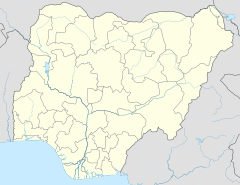Chad Basin National Park
| Chad Basin National Park | ||
|---|---|---|
|
|
||
| Location: | Nigeria | |
| Specialty: | Region Borno and Yobe | |
| Next city: | Gulumba , Bade , Yusufari | |
| Surface: | 2258 km² | |
The Chad Basin National Park is located in northeastern Nigeria and covers an area of 2258 km² in the states of Yobe and Borno . It consists of three geographically separated protection zones, the Chingurmi-Duguma area, the Bade-Nguru wetland and the Bulatura area. These include different biotopes of the Chad Basin , which lie in humid over semi-arid and arid areas.
Chingurmi-Duguma area
11 ° 45 ′ 0 ″ N , 14 ° 15 ′ 0 ″ E
The zone of the national park in the state of Borno covers an area of 1228 km² and is located on the border with Cameroon , near the Waza National Park . The vegetation largely corresponds to that of the Western Sudan savannah, which merges into the vegetation zone of the Sahel-acacia savannah in the north of the park . The predominant tree species are acacia , oscher ( Calotropis procera ), Anogeissus leiocarpus , desert date ( Balanites aegyptiaca ) and the stink tree Sterculia setigera .
The area is crossed by the seasonally flowing river Dorma, in the rainy season it floods larger areas that form the biotope of the Kutila Fadama. The most widespread trees in this biotope belong to the Mitragyna inermis plant species .
The red-fronted gazelle ( Gazella rufifrons ), the African elephant ( Loxodonta africana ) and, during the rainy season, the giraffe ( Giraffa camelopardalis ), which is considered extinct in the rest of Nigeria, live in this area of the national park .
Bathing Nguru Wetland
12 ° 50 ′ 0 ″ N , 10 ° 50 ′ 0 ″ E
This area of the national park is located in the Hadejia-Nguru wetlands and covers an area of 928 km², which are formed by the Hadejia and Jama'are rivers in the state of Yobe . The core area of this protection zone is the Dagona water bird sanctuary, around Lake Nguru .
The Bade-Nguru wetland is located in the vegetation belt of the Sahel-acacia savannah of the Sahel zone , with its annual rainfall of 200 to 600 mm / m². There are three main specific types of vegetation in the area. The first is the shrub savannah, which spreads in the higher areas. The second is called tudu , which spreads on sandy soils and is criss-crossed by a large number of ponds. The predominant tree species are Anabaum ( Acacia albida ), Ziziphus species, the desert date ( Balanites aegyptiaca ), tamarind tree ( Tamarindus indica ) and African baobab ( Adansonia digitata ). The grasses Cenchrus biflorus , Andropogon species and Vetiveria nigritana can be found in their undergrowth . Gallery forests , known regionally as Kumri forests, extend along the river meadows . These consist mainly of the tree species Khaya senegalensis , Mitragyna inermis and Diospyros mespiliformis . In some areas, the Kumri forests have been replaced by plantations with mango ( Mangifera indica ) and real guava ( Psidium guajava ). The third type of vegetation spreads in the floodplains and is known regionally as Fadama . The main tree species are Acacia nilotica and Doum palm ( Hyphaene thebaica ). Large areas of grass spread out in the floodplains, the dominant species are the Echinochloa and Oryza species, in the drier areas of the Fadama vegetation the grasses Dactyloctenium aegyptium , Setaria species and Cyperus species. The taller Typha domingensis and Mimosa pigra grow on the banks of the lakes.
The great international importance of this part of the national park was underscored by the visits of the ambassadors of WWF , Bernhardt of the Netherlands and Prince Philipp, Duke of Edinburgh, in 1987 and Prince Charles and Lady Diana in 1990. The 1010.95 km² Baturiya Wetlands Game Reserve and the 581 km² Nguru Lake (and Marma Canal) Complex were added to the list of wetlands of international importance by the Ramsar Convention in 2008.
Bulatura area
13 ° 15 ′ 0 ″ N , 11 ° 0 ′ 0 ″ E
This area of the national park lies on the border with the landlocked state of Niger and covers an area of 92 km². It is a desert-like area covered by sand dunes and oases , making it a unique biotope for Nigeria.
Trivia
In 1999 the government of the state of Borno proposed to integrate the Sambisa Game Reserve into the national park, but this project was not fully implemented. The Sambisa Game Reserve is administratively managed by the national park, but is not legally part of the national park.
source
- Chad Basin National Park: Chingurmi - Duguma Sector on BirdLife
- CHAD BASIN NATIONAL PARK ( Memento from October 2, 2013 in the Internet Archive ) on the Nigeria Park Service website
Individual evidence
- ↑ The Annotated Ramsar List: Nigeria (English)
- ↑ CHAD BASIN NATIONAL PARK ( memento of October 2, 2013 in the Internet Archive ) on Nigeria Park Service (English)

